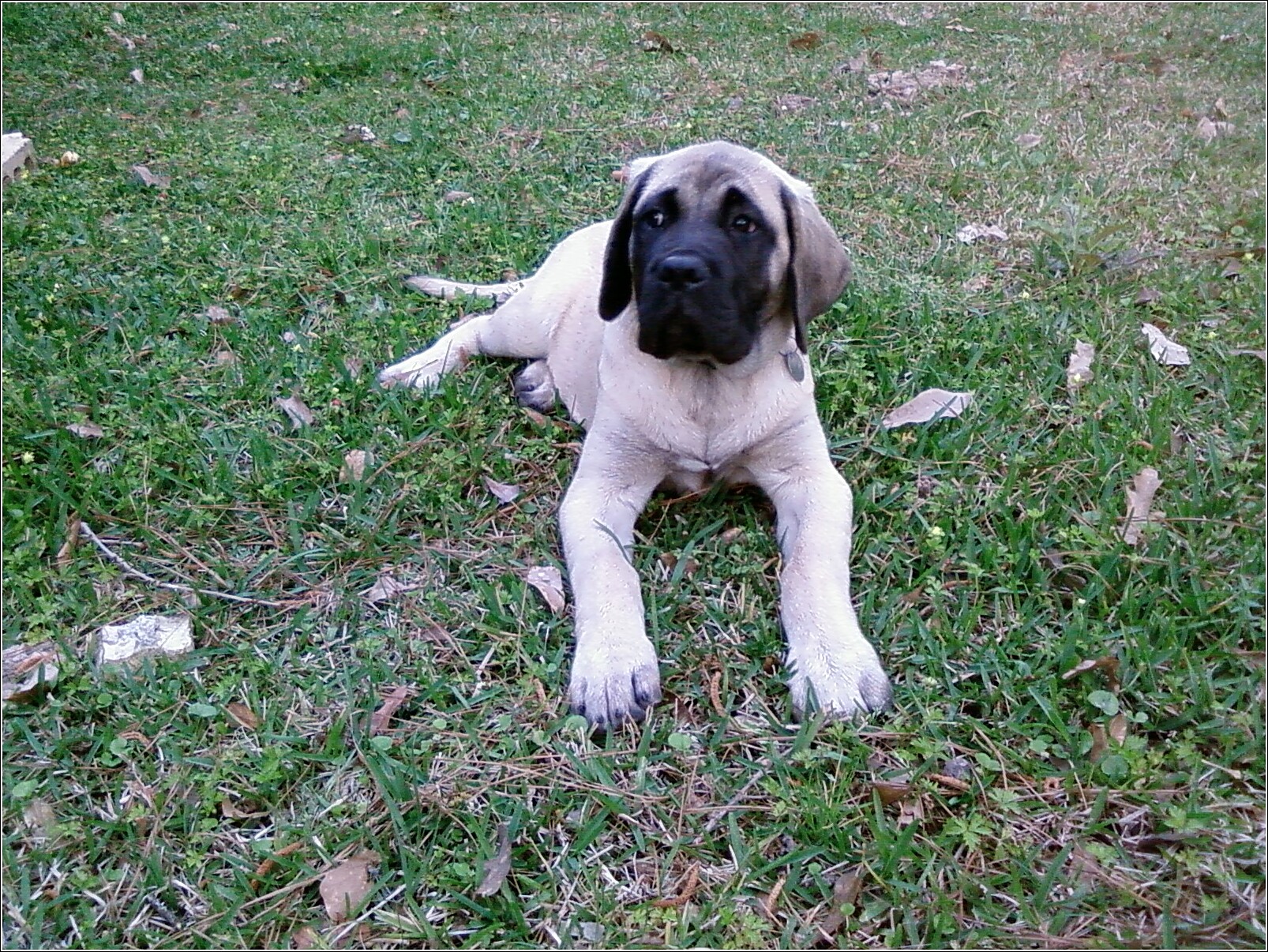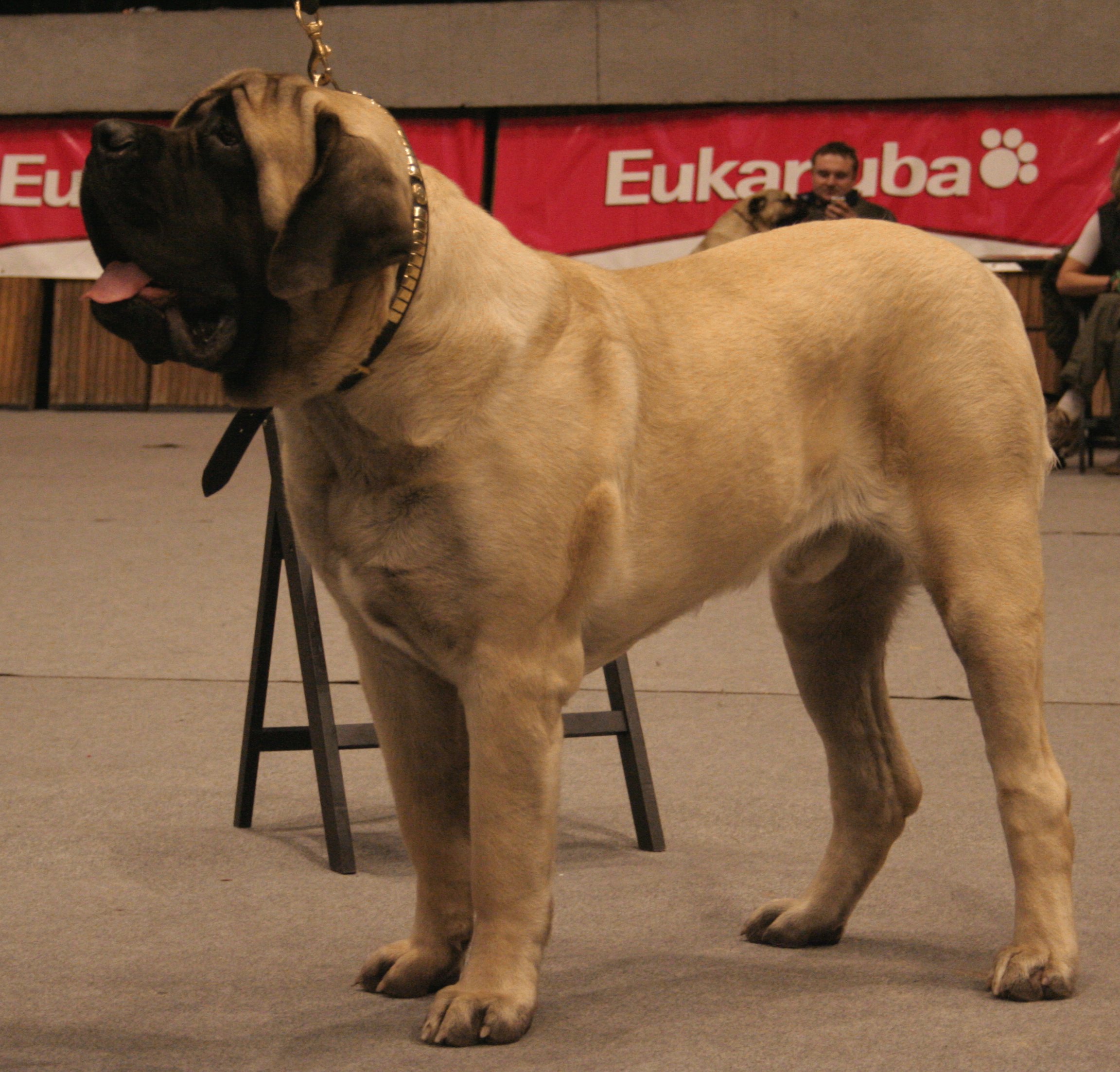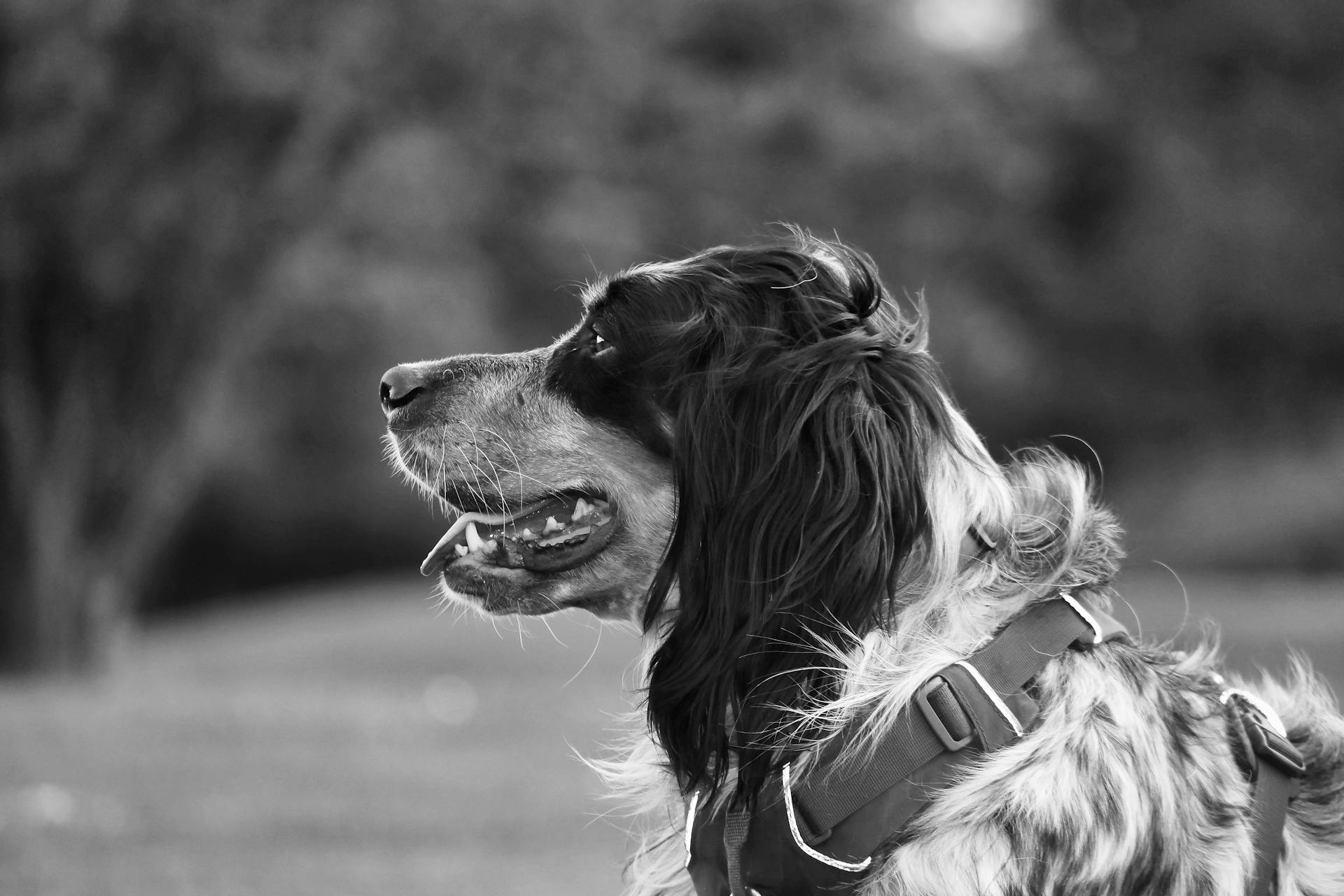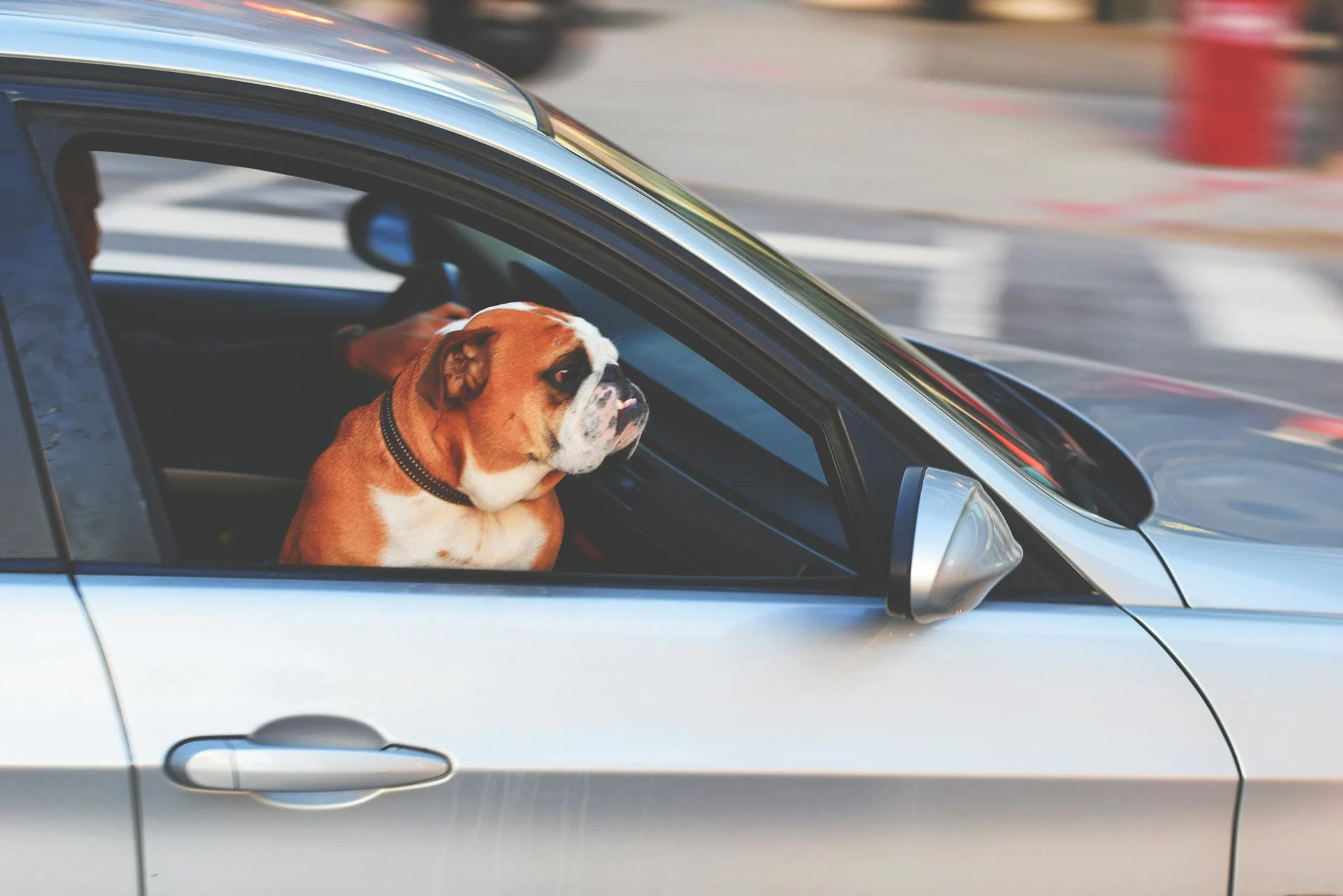
The White English Mastiff is a massive breed, weighing between 130 and 230 pounds.
They are known for their enormous size, with males reaching up to 30 inches in height.
Their massive build requires plenty of space to move around, so a spacious home is a must.
In fact, they need room to stretch out and exercise regularly to stay happy and healthy.
Despite their large size, White English Mastiffs are known for their gentle and calm nature.
They are often described as laid-back and easy-going, making them a great choice for families with children.
For more insights, see: Large Malamute
Breed Characteristics
The White English Mastiff is an impressive breed, and one of its most notable characteristics is its size. Males can weigh between 160-230 pounds (72-104 kg), making them one of the largest dog breeds.
They are also known for their loyal and protective nature, which is a result of their historical roots as guardians and warriors. With origins traced back to the Molossian war dogs of Greece, they have a rich history.
Their calm demeanor is also a notable trait, which is essential for their gentle nature to shine through. Proper training and socialization are crucial to ensure they remain well-behaved family members.
Here's a quick look at some of the Mastiff breeds and their characteristics:
Breeds
The English Mastiff is one of the largest dog breeds, with males weighing between 160-230 pounds (72-104 kg). They're truly massive animals.
The Neapolitan Mastiff, on the other hand, is known for its large, loose skin and heavy wrinkles on the face and body. They have a protective nature and were used as guard dogs.
The Bullmastiff is a mix of English Mastiff and Bulldog, developed in England to guard estates and catch poachers. They're large, powerful dogs, with males weighing around 100-130 pounds (45-59 kg).
Here are some of the Mastiff breeds, listed for easy reference:
- English Mastiff: Males weigh between 160-230 pounds (72-104 kg)
- Neapolitan Mastiff: Males weigh between 110-150 pounds (50-68 kg)
- Bullmastiff: Males weigh around 100-130 pounds (45-59 kg)
- Tibetan Mastiff: Males weigh between 90-150 pounds (41-68 kg)
- Dogue de Bordeaux: Males typically weigh between 110-145 pounds (50-66 kg)
- Brazilian Mastiff (Fila Brasileiro): Males weigh between 110 and 200 pounds (50 and 90 kg)
The Tibetan Mastiff has a thick double coat that protects them from harsh weather conditions.
Highlights
English Mastiffs are truly a sight to behold, with some of them reaching an impressive size that's hard to ignore.
Their historical roots are just as fascinating, tracing back to the Molossian war dogs of Greece and even serving in the Roman Empire during warfare.
Despite their intimidating size, these gentle giants are known for their calm and friendly demeanor, making them a joy to be around.
English Mastiffs are highly loyal to their families, which means they make excellent companions and protective members of the household.
To ensure their gentle nature is properly harnessed, proper training and socialization are essential, making them well-behaved family members.
Here are some key characteristics that make English Mastiffs stand out:
- Impressive Size: English Mastiffs are among the largest dog breeds.
- Gentle Temperament: They're known for their gentle and affectionate nature.
- Loyal Companions: English Mastiffs are highly loyal to their families.
- Calm Demeanor: They typically display a calm and friendly demeanor.
Care and Feeding
Mastiffs are individuals, just like people, and they don’t all need the same amount of food. The quality of dog food you buy also makes a difference–the better the dog food, the further it will go toward nourishing your dog and the less of it you’ll need to shake into your dog’s bowl.
Mastiffs are sloppy drinkers and leave plenty of backwash in their bowls. Rinse bowls daily or more often as needed.
To keep your Mastiff in good shape, measure their food and feed them twice a day rather than always leaving food out.
Additional reading: Photos of Mastiffs
Care

To keep your Mastiff in good shape, you should measure their food and feed them twice a day rather than always leaving food out.
Mastiffs are sloppy drinkers and leave plenty of backwash in their bowls, so be sure to rinse them daily or more often as needed.
A highly active dog will need more food than a couch potato dog, so consider your Mastiff's activity level when determining their daily ration.
The recommended daily amount for an adult Mastiff is 6 to 8 cups of high-quality dry food daily, divided into two meals.
You should be able to see a waist on your Mastiff when looking at them from above, and when you place your hands on their back, you should be able to feel but not see their ribs without pressing hard.
Mastiffs are prone to gastric torsion, also known as bloat, so avoid giving them large meals and letting them drink large amounts of water afterwards, and also avoid heavy exercise before or after meals.
Suggestion: Are Great Danes Mastiffs
Children and Pets
Mastiffs are large, active dogs that can accidentally knock a toddler down with a swipe of their tail.
It's best to have older children in a home with a Mastiff, as they can be too rough for younger kids.
Teach your child never to approach any dog while sleeping or eating, and never to try to take the dog's food away.
No dog should ever be left unsupervised with a child.
Mastiffs generally tolerate other dogs and cats, especially if they've been raised with them.
If you're adding a second adult Mastiff to your family, you may want to consider getting one of the opposite sex to avoid any arguments over who's top dog.
Health
The health of a White English Mastiff is a top priority, and for good reason. This breed is prone to several health issues due to its large size and rapid growth rate.
A Mastiff's diet and exercise needs are crucial to its overall health. Excessive running is not recommended for the first 2 years of a dog's life, as it can damage the growth plates in its joints.
Regular exercise is a must, however, to prevent slothful behavior and a range of health problems. A soft surface is recommended for the dog to sleep on to prevent calluses, arthritis, and hygroma.
A UK study found that the average life expectancy of a Mastiff is 9 years. However, this breed is susceptible to several major health problems, including hip dysplasia and gastric torsion.
Other potential issues include obesity, osteosarcoma, and cystinuria. It's essential to monitor your Mastiff's health closely and take preventative measures to avoid these problems.
If you're considering purchasing a purebred Mastiff, experts recommend that the dog undergo tests for hip dysplasia, elbow dysplasia, thyroid, and DNA for progressive retinal atrophy (PRA).
Here are some potential health issues that can affect Mastiffs:
- Hip dysplasia
- Elbow dysplasia
- Thyroid issues
- Progressive retinal atrophy (PRA)
- Gastric torsion
- Obesity
- Osteosarcoma
- Cystinuria
- Cardiomyopathy
- Allergies
- Vaginal hyperplasia
- Cruciate ligament rupture
- Hypothyroidism
- OCD
- Entropion
- Progressive retinal atrophy (PRA)
- Persistent pupillary membranes (PPM)
Training and Behavior
Training a white English Mastiff requires patience and consistency, as they can become shy, fearful, or aggressive if mishandled. They need early socialization, exposure to many different people, sights, sounds, and experiences, to grow up to be well-rounded dogs.
Mastiffs are naturally protective of their family, but they're not naturally vicious. They'll step between you and anyone or anything that seems threatening, but will also escalate their response as needed. This means they might look tough outside, but they're sensitive dogs who need gentle handling.
Choose a puppy with a nice temperament, one that's curious and playful, willing to approach people and be held by them. Meeting the parents, especially the mother, can help evaluate what a puppy will be like when they grow up.
You might enjoy: Shiba Inu .01
Temperament
The Mastiff breed has a desired temperament, which is reflected in all formal standards and historical descriptions. They're known for being noble, courageous, and gentle.
A well-socialized Mastiff treats normal strangers with polite aloofness but will step between you and anyone or anything that seems threatening. Their courage doesn't exceed their temper and generosity.
Mastiffs are sensitive dogs who can become shy, fearful, or aggressive if mishandled. Never treat your Mastiff roughly or allow anyone else, including children, to do so.
Early socialization is crucial for Mastiffs, and enrolling them in a puppy kindergarten class is a great start. Inviting visitors regularly and taking your pup to busy parks and stores that allow dogs will also help them polish their social skills.
A Mastiff's docility is perfect; they won't resent being teased by smaller dogs. They'll even down with their paw a Terrier or cur that has bitten them, without offering further injury.
Trainability
Training a pet requires patience and consistency. Dogs, for example, can be trained to respond to basic commands like "sit" and "stay" within a few weeks of consistent practice.
Positive reinforcement is a key factor in successful training. By rewarding good behavior with treats and praise, you can encourage your pet to repeat the desired action.
Some pets, like horses, are more intelligent and trainable than others. Horses can learn to perform complex tasks like jumping and agility training with proper training and equipment.
Consistency is crucial in training a pet, especially for young animals. A consistent routine and clear communication can help prevent confusion and misbehavior.
A well-trained pet can bring joy and companionship to your life, but it also requires ongoing effort and attention. Regular practice and reinforcement can help maintain good behavior and strengthen your bond with your pet.
Records and Recognition
The White English Mastiff is a rare and majestic breed. They are recognized by kennel clubs around the world, including the American Kennel Club (AKC) and the United Kennel Club (UKC).
Their unique appearance and gentle nature have earned them a spot in the hearts of many dog owners. The White English Mastiff is also known for its impressive size, with adult males weighing up to 230 pounds.
Despite their large size, White English Mastiffs are known for being gentle and laid-back, making them a great companion for families and individuals alike.
Related reading: American Kennel Club Lancashire Heeler
Breed Organizations
Mastiff breed organizations play a crucial role in ensuring the health and well-being of the breed. They set standards for breeding and provide resources for responsible ownership.
Reputable breeders are often members of these organizations and adhere to their codes of ethics. This means they prioritize breeding healthy, well-socialized puppies over making a profit.
Backyard breeders, on the other hand, may not be members of these organizations and often prioritize profits over the welfare of their dogs. As a result, puppies from backyard breeders are more likely to have health problems and behavioral issues.
Record Size
The largest dog in recorded history was an English Mastiff named Aicama Zorba of La Susa, who weighed a staggering 343 pounds.
This massive dog stood 37 inches tall at the shoulder and measured an incredible 8 ft 3 in from nose to tail, roughly the size of a small donkey.
Aicama Zorba's record-breaking size is still recognized today, although the Guinness Book of World Records stopped accepting largest or heaviest pet records after 2000.
Mastiffs, in general, are known to be large dogs, with males reaching a minimum height of 30 inches at the shoulder and females at 27.5 inches.
Their weight range is also impressive, typically falling between 130 pounds and 220 pounds or more.
If this caught your attention, see: Biggest Boxer Breed
List of Breeds

Mastiff breeds are known for their impressive size, with some weighing over 200 pounds.
The English Mastiff is one of the largest dog breeds, with males weighing between 160-230 pounds.
The Neapolitan Mastiff has large, loose skin and heavy wrinkles on the face and body, making them a distinctive breed.
They are muscular and can weigh between 110-150 pounds, with a protective nature that makes them great guard dogs.
The Bullmastiff is a mix of English Mastiff and Bulldog, developed in England to guard estates and catch poachers.
They are large, powerful dogs, with males weighing around 100-130 pounds.
The Tibetan Mastiff has an impressive appearance and protective nature, with a thick double coat that protects them from harsh weather conditions.
Males weigh between 90-150 pounds, and are known to be independent and strong-willed dogs.
The Dogue de Bordeaux has a large, muscular build and a distinctive wrinkled face, with males typically weighing between 110-145 pounds.
Curious to learn more? Check out: Bernese Mountain Dog Protective

The Brazilian Mastiff, also known as the Fila Brasileiro, has a strong prey drive and a protective nature, making them a great breed for experienced owners.
Here are some of the Mastiff breeds and their typical weights:
General Information
The White English Mastiff is a gentle giant, weighing between 130-230 pounds and standing 23-28 inches tall at the shoulder.
They are a relatively old breed, with origins dating back to the 16th century in England.
These massive dogs were originally bred for guarding and companionship.
Their short coats require minimal grooming, making them a great choice for busy owners.
Their calm and even-tempered nature makes them an excellent choice for families with children.
They are prone to joint issues and other health problems due to their large size.
Regular exercise and a balanced diet are crucial for maintaining their overall health and well-being.
Despite their size, they are known for being relatively low-maintenance pets.
Frequently Asked Questions
What is the rarest color of English mastiffs?
The rarest color of English Mastiffs is black, due to its extremely low occurrence. However, its genetic basis remains unclear.
What is the best color for English Mastiff?
The most popular and desirable color for English Mastiffs is fawn, which can range from light grayish-brown to light yellowish tan. Discover the unique characteristics and growth patterns of fawn Mastiffs to learn more about this beloved breed.
Is an English Mastiff a good pet?
The English Mastiff makes a loyal and loving companion for families with older children, but may not be suitable for households with toddlers due to its large size. If you're considering bringing a Mastiff into your home, it's essential to research their needs and temperament.
Featured Images: pexels.com


